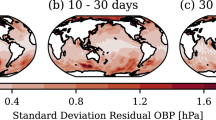Summary
In a high resolving (mean grid size 11 km) barotropic numerical model of the North Sea tides the M2-tide is computed. Nonlinearities of the Navier-Stokesequation yield, in connection with an annual mean wind stress, a residual circulation fitting well to observational data. Some effects of this circulation are discussed in connection with pollution problems.
Zusammenfassung
In einem hochauflösenden (mittlerer Gitterabstand 11 km) barotropen Modell für die Gezeiten der Nordsee wird die M2-Gezeit berechnet. Verschiedene Nichtlinearitäten der Bewegungsgleichungen führen in Verbindung mit einem mittleren Windschub zu einer Restzirkulation, die mit Beobachtungen in Einklang steht. Einige Effekte dieser Zirkulation in Zusammenhang mit Verschmutzungsproblemen werden diskutiert.
Résumé
L'onde marée M2 est calculée dans un modèle numérique barotropique de la mer du Nord de haute résolution (l'espacement moyen entre les lignes de quadrillage étant de 11 km). Des non-linéarités de l'équation Navier-Stokes produisent, en connection avec une force moyenne annuelle du vent, une circulation résiduelle s'accordant bien avec les données observées. Certains effects de cette circulation sont discutés, en relation avec les problèmes de pollution.
Similar content being viewed by others
References
Böhnecke, G., 1922: Salzgehalt und Strömungen der Nordsee. Veröff. Inst. Meeresk. Univ. Berlin, N.F. (A) No 10, 34 S.
Goedecke, E., 1941: Beiträge zur Hydrographie der Konvergenz der Deutschen Bucht. Ann. Hydrogr. marit. Met.69, 345–362.
Hansen, W., 1956: Theorie zur Ermittlung des Wasserstandes und der Strömungen in Randmeeren nebst Anwendungen. Tellus.8, 287.
Heaps, N., 1974: Private communication.
Kautsky, H., 1973: The distribution of the radio nuclide Caesium 137 as an indicator for North Sea watermass transport. Dt. hydrogr. Z.26, 241–246.
Kuhlbrodt, E., H. J. Bullig, P. Bintig et al., 1954: Klimatologie der Nordwesteuropäischen Gewässer. Einzelveröff. Dt. Wetterd., Seewetteramt, Nr. 4.
Laevastu, T., 1963: Serial Atlas of the Marine Environment. Fol. 4. Publ. by Amer. Geogr. Soc., New York.
Maier-Reimer, E., 1975: Zum Einfluß eines mittleren Windschubes auf die Restströme der Nordsee. Dt. hydrogr. Z.28, 253–262.
Nihoul, J. C., 1975: Hydrodynamic models o. the North Sea. Proc. of the VII Liège Coll. on Ocean hydrodynamics.
Zahel, W., 1970: Die Reproduktion gezeitenbedingter Bewegungsvorgänge im Weltozean mittels des hydrodynamisch-numerischen Verfahrens. Mitt. Inst. Meeresk. Univ. Hamburg. Nr. 17, 50 S.
Zahel, W., 1976: A global hydrodynamicnumerical 1°-model of the ocean tide, the oscillation system of the M2-tide and its distribution of energy dissipation. Annales de Géophysique [in press].
Author information
Authors and Affiliations
Rights and permissions
About this article
Cite this article
Maier-Reimer, E. Residual circulation in the North Sea due to the M2-tide and mean annual wind stress. Deutsche Hydrographische Zeitschrift 30, 69–80 (1977). https://doi.org/10.1007/BF02227045
Received:
Issue Date:
DOI: https://doi.org/10.1007/BF02227045




